

Embodied_Cog_PBR.pdf. Embodied Cognition is Not What you Think it is. Introduction The most exciting idea in cognitive science right now is the theory that cognition is embodied.
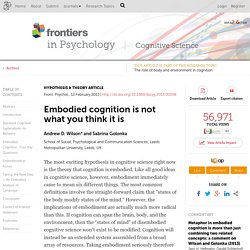
It is, in fact one of the things interested lay people know about cognitive science, thanks to many recent high profile experiments. These experiments claim to show (1) how cognition can be influenced and biased by states of the body (e.g., Eerland et al., 2011) or the environment (Adam and Galinsky, 2012) or (2) that abstract cognitive states are grounded in states of the body and using the former affects the latter (e.g., Lakoff and Johnson, 1980, 1999; Miles et al., 2010). A Brief Guide to Embodied Cognition: Why You Are Not Your Brain - Guest Blog - Scientific American Blog Network.
Embodied cognition, the idea that the mind is not only connected to the body but that the body influences the mind, is one of the more counter-intuitive ideas in cognitive science.
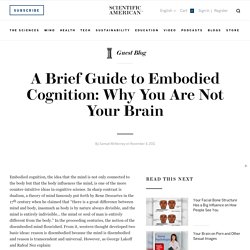
In sharp contrast is dualism, a theory of mind famously put forth by Rene Descartes in the 17th century when he claimed that “there is a great difference between mind and body, inasmuch as body is by nature always divisible, and the mind is entirely indivisible... the mind or soul of man is entirely different from the body.” In the proceeding centuries, the notion of the disembodied mind flourished. From it, western thought developed two basic ideas: reason is disembodied because the mind is disembodied and reason is transcendent and universal.
Abnormal melatonin synthesis in autism spectrum disorders. Character Strengths and Virtues. 2004 book by Christopher Peterson and Martin Seligman In the same way that the Diagnostic and Statistical Manual of Mental Disorders assesses and facilitates research on mental disorders, CSV is intended to provide a theoretical framework to assist in developing practical applications for positive psychology.[1] Definition of strengths and virtues[edit]
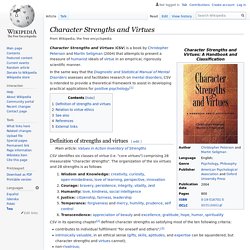
Understand Context Blindness, Asperger's Brain Behaviour & Traits. List of memory biases. In psychology and cognitive science, a memory bias is a cognitive bias that either enhances or impairs the recall of a memory (either the chances that the memory will be recalled at all, or the amount of time it takes for it to be recalled, or both), or that alters the content of a reported memory.

There are many different types of memory biases, including: See also[edit] [edit] ^ Jump up to: a b c d e Schacter, Daniel L. (1999). "The Seven Sins of Memory: Insights From Psychology and Cognitive Neuroscience". References[edit] How Much Asperger's Is Really Face or Emotion Blindness? Prosopagnosia Research - About Prosopagnosia. Prosopagnosia. Animation of the fusiform area, the area damaged in prosopagnosia.
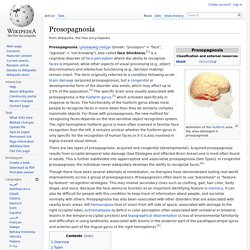
Prosopagnosia /ˌprɒsəpæɡˈnoʊʒə/ (Greek: "prosopon" = "face", "agnosia" = "not knowing"), also called face blindness,[1] is a cognitive disorder of face perception where the ability to recognize faces is impaired, while other aspects of visual processing (e.g., object discrimination) and intellectual functioning (e.g., decision making) remain intact. The term originally referred to a condition following acute brain damage (acquired prosopagnosia), but a congenital or developmental form of the disorder also exists, which may affect up to 2.5% of the population.[2] The specific brain area usually associated with prosopagnosia is the fusiform gyrus,[3] which activates specifically in response to faces. The functionality of the fusiform gyrus allows most people to recognize faces in more detail than they do similarly complex inanimate objects.
Do you suffer from face blindness? Seven signs and symptoms of prosopagnosia. Attunement. Successful Schizophrenia. Home | Articles | Resources | Stories | Weller-than-Well | Links | Search.

Vibrant Healthy Energy. How To Think With Your Hands. Monday, June 24, 2013 Over the past few years, while working on my forthcoming book Brilliant, I’ve been watching and taking note as a new conceptualization of intelligence takes shape in the social and biological sciences.

This conceptualization involves many lines of inquiry that can be loosely grouped under the title situated cognition: the idea that thinking doesn’t happen in some abstract, disembodied space, but always in a particular brain, in a particular body, located in a particular social and physical world. Brain-Based Learning. Institute for Applied Psychometrics (IAP) IQ's Corner. New Mentality. Psychology Tomorrow MagazinePsychology Tomorrow Magazine. Projects. Virtual Schizophrenia. Virtual Reality and Mental Illness Virtual Schizophrenia spotlighted on ABC News 20/20 But what is it really like to see the strange visions or hear the bizarre voices?
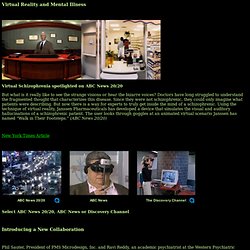
Doctors have long struggled to understand the fragmented thought that characterizes this disease. General Symptoms of SPD in Adults. Here is a very basic, traditional checklist for adults with SPD.
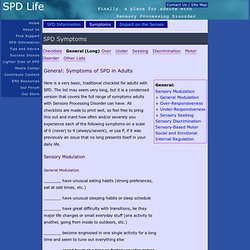
The list may seem very long, but it is a condensed version that covers the full range of symptoms adults with Sensory Processing Disorder can have. All checklists are made to print well, so feel free to pring this out and mard how often and/or severely you experience each of the following symptoms on a scale of 0 (never) to 4 (always/severe), or use P, if it was previously an issue that no long presents itself in your daily life. Sensory Modulation General Modulation _______ have unusual eating habits (strong preferances, eat at odd times, etc.) Si-alert_program.pdf. International OCD (Obsessive Compulsive Disorder) Foundation. The International OCD Foundation (IOCDF) - Hoarding Center. We are excited to announce that for the second year in a row, we will be holding the Annual Hoarding Meeting at the Annual OCD Conference.

The 2nd Annual Hoarding Meeting provides critical information to individuals, families, and loved ones affected by hoarding disorder, with the goal of improving access to effective and compassionate treatment and care. The Annual Hoarding Meeting also offers an opportunity for professionals — from therapists and social workers to firefighters and other public safety officials — to learn how to most effectively and compassionately work with individuals with HD. Professionals will hear from leading researchers and experts in the field, and will walk away with new understanding and practical strategies for working with those affected by HD. Click here to learn more... Institute for Challenging Disorganization. Squalor Survivors. I'm Pigpen and I used to live in squalor. I spent much time and energy trying to hide the true state of my house - clutter and mess - from people. Finally, I realized I had a real problem.
I worked to change how I thought about, and kept, my house. My house isn't messy any more. Squalor Survivors - Measuring squalor. Measurement tools have been developed to quantify the scale of a clutter and hoarding problem.. Submerged in stuff, hoarders keep collecting - Health - Mental health. For actress Delta Burke, it was antique furniture and porcelain dolls — enough to fill 27 climate-controlled storage units. For Roger Gorman’s father-in-law, it was books, newspapers, plastic grocery bags and leisure magazines.
“There must have been over 2,000 magazines in his apartment,” says the 53-year-old graphic designer from Manhattan. “There were stacks and stacks of them, columns of them. It looked like the landscape of a city.” AUT_Unit3.4 Sensory Self-Regulation.pdf.